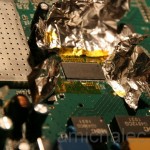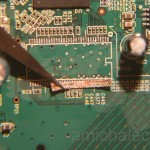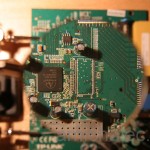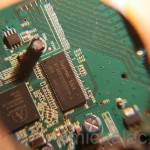When I read about hardware modifications of unextendable home-targetted routers, I thought, nerds! On the other hand, doubling RAM memory size for pennies, is attractive perspective for anyone, who plans switch firmware to embedded linux and host services far beyond than typical network functionality. At that time I already had cheap amateur PT-936 soldering station, just for simple repairs. To replace memory chip however, SMT element must be unsoldered, which in turn requires soldering station with hotair gun. Some people uses even paitwork removing heatgun but for me it was too unsafe, with possibility of destroying dismounted chip and no way back if something goes wrong.
This was turning point, a moment when I decided to start over my electronic hobby dropped off years ago. I wanted be one of these geeks :] I sold PT-936 out and bought amateur SMT rework station, PT-803, and started collecting basic electronic equipment, but this is another story. I played a bit on PCB from dead HDD which had surface-mounted chips with similar pins density – watching videos on youtube, unsoldering and soldering back couple times helped me to get basic skills with SMD.
Opening up the case is tricky part. After unscrewing screws hidden behind rubber stands, top and bottom white parts need to be opened a bit near the back (antenna) side of case. This allows to move U-shaped black frame few millimeters back, leaving holes on both sides of front panel. Be careful, moving black frame to vigorously back will tear off antenna’s cable inside the case. Safer way is to unscrew nuts of antenna socket before moving frame, and push sockets inside the case (you can easily screw them back later). Having black frame shifted back, there is an acces through the holes to latches that are keeping top and bottom parts together. Once they are detached the case is open and PCB can be removed.
RAM modification requires unsoldering 66 pins TSOP memory chip keeping in mind surrouding heat-sensitive electrolitic capacitors. You can either dismount them for the time of chip unsoldering, or shield them. I decided make up a cover from tin-foil and attached to PCB with kapton tape; keeping it in place is a must, since airflow can blow that shield. Improvised shield was not stiff enough and stream of hot air bent the foil a bit, that touched one of caps and melted slightly its cover.
After unsoldering, by the books, pads need to be cleaned up from remaining solder. It eases laying down and aligning the element; any irregularity bumps up a bit line of pins and some of them may not get connected. Wire tape soaked in flux absorbs solder when heated up.
The next step was pinning down the chip in right position. After alignment I simply soldered two diagonal pins – this way alignment can be easily corrected.
Of course you have to have right chip before. My motherboard revision is 1.7 with Zentel A3S56D40FTP-G5 chip. Most people discussed earlier hardware revisions with Hynix on board. I was concerned if I can succeed with popular Hynix HY5DU121622CTP-J transplant. Hopefully memory addressing and pin order was the same. Other compatible chips would work too.
You may notice different clock speeds of memories, oryginal 32MB is rated at 200MHz, as WR1043 Atheros is clocked at 400MHz, while 64MB chips are 166MHz only. It is widely verified, me included, that this overclocked memory works very stable.
Even though soldering can be done with naked eye I decided to use another cheap device, chineese magnifying glass with mounting clamps. The lens 9cm diameter gives view of working area for both eyes, making work under glass easy to adapt. After all what I was missing here was proper light. Professional lens has round light around it giving fuzzy enlightment. Spot light I used is reflective; looking at shiny solder is tiring in long terms. I am not disappointed however, professional lamp with zoom costs 30 euro or more, chineese way was 5 euro.
Soldering station for 60 euro does not have miniwave tip, but 0.25mm diameter solder wire works perfect in manufacture: lay down flux and chunk of solder wire on pins and heat one pad by another. Unsoldering took me 10 minus, including preparation. Soldering in contrast, took 40 minutes; I was slow and precise, plus I have verified all pads with 10x watch repairmans’ lens.
Most exciting moment comes last. In case of WR1043ND, resoldering 64MB memory is the only step you need to make, no firmware modification on binary level and so on. Running modified motherboard is all about success or another hour of resoldering. In my case it was flawless, device booted up, loaded from pendrive and I could connect to console. Last check with “free” command revealed doubled memory! Voila!
If you liked this article, help me to maintain blog on electronics and donate!
![]()











I couldn’t find anywhere instructions for opening the case of TL-WR1043ND.
Excellent site!
Thanks a lot!
%-) people who can’t open the case, never be able to rewire the memory chip ))
Hello,
Do no know a such mod for flash rom on this hardware?
Are you simply looking for more storage than built-in 8MB? If so, you should look at “extroot” – the way to have file system on external storage (like SD card or HDD); however it will use the only USB port (and this is why I made USB modification).
I have TPlink wr1043dn. can I extroot the router as the router supports usb.
Thanks
I can’t hear anhyintg over the sound of how awesome this article is.
very good 🙂
where did u get the chip from? are u intrested in doing this ram mod on mine for a fee? nicko42004200@yahoo.com is my email. thanks
I bought SODIMM RAM module on bidding service similar to ebay, carefully looking for specific chips asking sellers to either send me detailed picture or chip description. I sold out remaining seven chips within couple hours due to popularity of this modification. My advice: look for compatible chip (link to the list is in the article) and then find GSM repair shop and ask them for chip resoldering; it will be faster and cheaper than sending router over the world 😉
With the stock 32mb ram most people say that the largest file you cab download via torrent is around 4.4gb . So I was wondering are you able to download larger files once you have upgraded the memory to 64mb? If so then what is the largest foly you can download without the router rebooting like crazy
I have recently downloaded 14GB ISO file without problem. I doubt 4.4GB limit is RAM oriented, if so it is more about virtual memory (you can however always configure swap file). I would bet it is USB problem that may lead to files corruption, I observed side-effects similar to this with first USB hub I used in my mod.
Wow, that’s awesome. Im using a 16GB G3 Kingston usb. and the max read speed I get while copying it from Windows Network mapped drive to any other drive, is 6MB/s Avg 4MB/s
I made the memory upgrade with a Samsung K4H511638C-UCB3. It is working like a charm even if the memory is only DDR333. Maybe this information is usefull for other people.
Also I upgraded firmware with a custom made openwrt made by a romanian guy Dani.
Firmware is including samba, UPnP, watchcat, dynamic server, printer server and support for IPv6. You can find the firmware for WR1043ND, tested and working with V1.8, V1.9, V1.10 and V11, here: http://www.internet6.ro/firmware/tp-link-wr1043nd/ .
On that site you can find firmwares for other routers too. Use the at your own risk because you will loose warranty and you may brick your rooter.
Please note that I did not brick my routers WR104rND V1.10 and WDR3600 V1.4.
How about change the CPU / processeor of the device ?
Think of it in terms of effort/cost to benefits ratio. RAM mod is very popular and moderately easy to apply: RAM chip is $5 plus replacement time (or GSM service fee of $10) to get new possibilities on software site. Other elements have more coupled design and while theoretically possible total cost is lower if the whole platform is replaced…
If the question is purely about hacking (no benefits/costs bias) then we have a problem: Atheros does not publish documentation for their SoC chips, only companies designing hardware with non-disclosure-agreement can get it.
Pingback: Anonymous
Hi. Thanks for the assist, everything works great 🙂